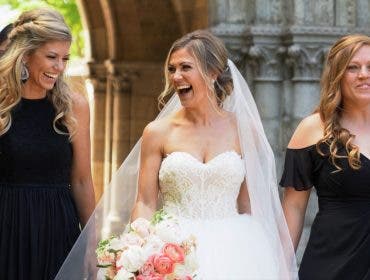Filming a wedding as a solo shooter may get your adrenaline pumping, and it’s perhaps the best way to hone your craft early on, but believe me, solo shooting is far from easy. On any given wedding day you have to juggle two cameras, multiple lenses, film settings, audio, stabilizers, and – you get the picture. Oh right, and you’re in charge of all this plus keeping the couple comfortable, happy and looking their best.
Did I mention solo shooting’s stressful?
While it can wipe you out, and it definitely tests your limits, I think every beginning wedding filmmaker should try at least one wedding on their own. This way you can comprehend the ins and outs of every detail while simultaneously understanding the potential wedding day mishaps — and how you can keep them at bay.
To give you a leg up on your first solo shoot, here are six mistakes you could make as a solo wedding filmmaker — and how to avoid them.
1. Forgetting to sync camera settings
If you’re shooting with two cameras — which you definitely should be (especially if you’re delivering a longer feature film) — you’ll want each camera’s footage to blend together. Sure, your prep footage will look different than your establishing shots, but for scenes such as the first look or ceremony where you’re syncing up two cameras, make sure you’re using the same white balance and coloring for a smooth transition between shots. It’s also smart to match up your date and time for easier syncing in post.
2. Rushed lens changes
As you’re frantically running from scene to scene, it’s easy to speed through changing your lenses, but this is a big no-no, especially if you have a mirrorless camera like the Sony Alpha series. Even the tiniest particles of dust can show up in your shots (trust me, I speak from experience), so use a dust blower every single time you change lenses — it’s worth the extra minute for speck-free footage.
3. Unstable gimbals
When you’re solo shooting a wedding, it may feel like you’re juggling a dozen gadgets at once because, well, you are. To set yourself up for high-quality footage, take the necessary time to stabilize your gimbal so you can benefit from its smooth-moving features instead of attempting to fix jumpy footage in post.
One helpful way to do this? Invest in tripod feet. I spent my first two weddings attempting to stabilize while holding my gimbal between my knees… and it didn’t go so well. Once I invested in tripod feet, everything changed. I’d also recommend investing in quick-release plates so your camera is always installed in its pre-balanced position.
4. Filming for other filmmakers instead of your couple
One thing I’ve noticed across wedding industry groups is that filmmakers often shoot to impress each other more than their actual clients. Sure, if you have a team of two or three shooters you can attempt the epic overhead drone dancing shots, but when you’re flying solo, you’re better off focusing on their actual reactions and those intimate, candid looks only a zoom can catch. I realize a camera on a monopod is hardly as “cool” as some of today’s newer gadgets (and I do use drones because those shots are cool!), but at the end of the day, don’t jeopardize this once-in-a-lifetime footage for the sake of an epic shot. Save your creative shots for early in the day or evening so you’re guaranteed to get the footage you need.
5. Not checking audio levels
Audio may be the trickiest part of the solo wedding filmmaker’s day because you’re juggling level tests while simultaneously setting up for speeches and first dances. If I’m solo shooting, I skip cocktail hour to work with the DJ or band to plug in my H4N recorder and test audio levels before the room’s filled with people. Of course, if I do get set up early, I reward myself with some cheese and crackers in the remaining minutes of cocktail hour. Follow this Beginner’s Guide to Wedding Film Audio to make sure you’re getting the basics down for those crucial sound moments.
6. Forgetting to press “on”
I hate that this is even on my list of mistakes, but perhaps the worst mistake of all is failing to actually turn on your gear. When you’re running around setting up tripods and determining your positions for the ceremony, you may forget to turn on your groom’s mic. Or, if toasts unexpectedly get moved up in the schedule, you may find yourself frazzled in an attempt to get the right spot — but don’t forget to actually press “record” on your H4N in the process. Fortunately, I haven’t run into major issues with this one, but I’ve heard horror stories that keep me up at night.
While it may seem like it, this guide is not meant to scare you out of solo shooting weddings. You should absolutely give it a shot! As long as you’ve mentally prepared and feel comfortable with your gear, your solo shooting day will undoubtedly turn out great for your couple, and even better for your long-term career.
Feature photo via Shutterstock






